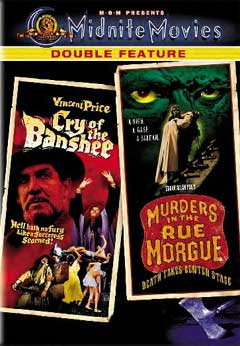 CRY
OF THE BANSHEE (1970)/MURDERS IN THE RUE MORGUE
(1971)
CRY
OF THE BANSHEE (1970)/MURDERS IN THE RUE MORGUE
(1971)Director: Gordon Hessler
MGM
 CRY
OF THE BANSHEE (1970)/MURDERS IN THE RUE MORGUE
(1971)
CRY
OF THE BANSHEE (1970)/MURDERS IN THE RUE MORGUE
(1971)In their latest batch of "Midnite Movies," MGM has wisely decided to double feature CRY OF THE BANSHEE with MURDERS IN THE RUE MORGUE, two AIP titles consecutively directed by Gordon Hessler. Following last year's excellent pairing of THE OBLONG BOX with SCREAM AND SCREAM AGAIN, MGM again does things completely right, releasing beautiful director's cuts of BANSHEE and RUE MORGUE, and including two great featurettes with Hessler.
The first film, 1970's CRY OF THE BANSHEE has suffered over the years to terrible reviews, and as a horror film, it's well known for having a bad reputation. Most of this criticism is attached to the U.S. version which was re-edited, cut, and re-scored--the British version, presented here on DVD, is far superior. Hessler was working under obvious budget constraints, but he and screenwriter Christopher Wicking (reinventing a story by Tim Kelly) were still able to turn out a decent gothic horror film in the grand tradition that American International was known for.
(Warning: possible spoilers
here) The story has a tyrannical magistrate, Lord Edward Whitman (Vincent
Price) and his doomed family fighting off witchcraft in old England. Whitman
and one of his henchmen kill two children at one of his ballroom galas all because
the girl refused his 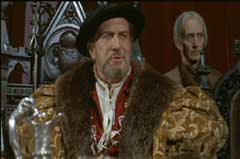 slobbering
advances, and her brother because he aggressively tried to protect her. Whitman's
young, frail looking wife Lady Patricia (Essy Persson), screams out, "murderer,"
after being repulsed by her husband's heartless actions. Whitman's chauvinist,
pig headed adopted son, Sean (Stephen Chase) exclaims, "Watch your tongue
girl, he can easily find another wife." Lord Whitman automatically agrees,
showing no remorse whatsoever. This scene is very reminiscent of the one in
Terence Fisher's CURSE OF THE WEREWOLF, where the Marquis' young bride is offended
the way he makes sport of a starving beggar during a banquet. When it is discovered
that the perpetrator of witchcraft is Oona (silent film star Elizabeth Bergner
in her final role), an aged coven leader, the Whitmans consider the rituals
obscene and violently interrupt the proceedings (this scene was heavily edited
in the US version, and rearranged as a pre-credit sequence).
slobbering
advances, and her brother because he aggressively tried to protect her. Whitman's
young, frail looking wife Lady Patricia (Essy Persson), screams out, "murderer,"
after being repulsed by her husband's heartless actions. Whitman's chauvinist,
pig headed adopted son, Sean (Stephen Chase) exclaims, "Watch your tongue
girl, he can easily find another wife." Lord Whitman automatically agrees,
showing no remorse whatsoever. This scene is very reminiscent of the one in
Terence Fisher's CURSE OF THE WEREWOLF, where the Marquis' young bride is offended
the way he makes sport of a starving beggar during a banquet. When it is discovered
that the perpetrator of witchcraft is Oona (silent film star Elizabeth Bergner
in her final role), an aged coven leader, the Whitmans consider the rituals
obscene and violently interrupt the proceedings (this scene was heavily edited
in the US version, and rearranged as a pre-credit sequence).
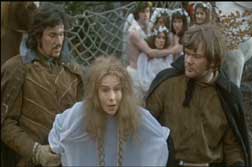 The
slaughter of coven members leads to revenge by Oona and her pack. Little does
the Whitman family know that Roderick (Patrick Mower), a young man who tends
to Lady Patricia and is romancing daughter Maureen (Hilary Dwyer), has been
cursed as a Sidhe--a demon in disguise sent by Oona to destroy the Whitmans.
He ends up turning wolf-like under Oona's will and kills off the family one
at time. First Sean is attacked, followed by Lady Patricia. Harry (Carl Rigg),
Whitman's real son, is able to locate the hiding place of Oona's coven, a crypt
bearing the inscription "Born by fire, dies by fire," which is significant
to the film's conclusion.
The
slaughter of coven members leads to revenge by Oona and her pack. Little does
the Whitman family know that Roderick (Patrick Mower), a young man who tends
to Lady Patricia and is romancing daughter Maureen (Hilary Dwyer), has been
cursed as a Sidhe--a demon in disguise sent by Oona to destroy the Whitmans.
He ends up turning wolf-like under Oona's will and kills off the family one
at time. First Sean is attacked, followed by Lady Patricia. Harry (Carl Rigg),
Whitman's real son, is able to locate the hiding place of Oona's coven, a crypt
bearing the inscription "Born by fire, dies by fire," which is significant
to the film's conclusion.
Wicking's script gives sympathy
is given to the "witch" characters due to the fact that the Whitmans
are so unlikable. The Whitman men are nothing more than self- indulgent 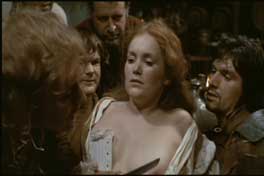 opportunists.
Like any typical witch hunter, Lord Whitman kills with out conscience in order
to impress and placate the people he rules over. Because of his failure in finding
real witches, he burns a pretty young girl in the village square to show the
crowd that he's doing his job, as well as giving them a spectacle to enjoy.
He has no respect for women, and he is instrumental in the mental breakdown
of his wife. Sean is foul in every sense of the word. He uses his position and
power to barge into the local inn and abuse a poor, defenseless young girl.
He uses witchcraft as an excuse to do so; the girl possessed some unidentifiable
herbs,
opportunists.
Like any typical witch hunter, Lord Whitman kills with out conscience in order
to impress and placate the people he rules over. Because of his failure in finding
real witches, he burns a pretty young girl in the village square to show the
crowd that he's doing his job, as well as giving them a spectacle to enjoy.
He has no respect for women, and he is instrumental in the mental breakdown
of his wife. Sean is foul in every sense of the word. He uses his position and
power to barge into the local inn and abuse a poor, defenseless young girl.
He uses witchcraft as an excuse to do so; the girl possessed some unidentifiable
herbs, 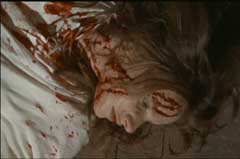 making
her suspicious. He's nothing more than an opportunist, getting his jollies by
molesting her and at the same time, putting on a show for his comrades.
making
her suspicious. He's nothing more than an opportunist, getting his jollies by
molesting her and at the same time, putting on a show for his comrades.
Harry seems to be sympathetic
and levelheaded, but he turns out to be just as much an opportunist as Sean.
After being away at school he returns home with a new priest (Marshall Jones),
trying to do good, as opposed to others in his family. He hates barbarity but
ends up killing twice. He slays one of the Whitman house lackeys in order to
prevent him from further torturing a girl from Oona's coven. He has also sworn
to avenge the death of Sean (who was torn apart at the hands of Roderick's alter
ego, the sidhe) by killing Oona. The truth of the matter is that he hated Sean,
and he openly admits that his determination to get revenge is a matter of principle.
He is obviously just another opportunist, killing Oona to selfishly prove his
manhood to himself. The only likable Whitman child is Maureen. She sees the
beauty in life and wants only to move away with her beloved Roderick.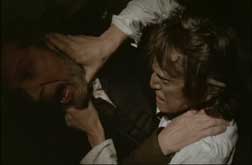
Roderick himself is a exceptional person, in his human figuration that is. He is the only one who can comfort Lady Patricia, who's on the verge of madness at the hands of the Whitman house. He can calm all animals, as savage as they may be. He saves a child from the wrath of a rabid, wild dog. This only makes it more unacceptable to the audience that he is the one cursed, much like the sympathy Larry Talbot garnishes in THE WOLFMAN (1941). Oona is a witch, but she is driven to do evil because of the cruelty of Lord Whitman. During her ceremonies, she burns dolls that are made up to represent the Whitmans. Each time one is thrown into flames, Roderick be comes a Sidhe and kills. After Harry Whitman slices Oona's throat, she tells her children "to continue their ways of love and peace!" This is a fascinating angle that is not carried out fully. Oona practices witchcraft, but only unleashes hatred and death when it is brought against her people.
For the most, the film is effectively
executed due to Hessler's sharp direction. He is able to get a serious and snarling
yet non hammy performance (nothing new but very good) out of Price, and the
rest of the reliable cast is able to carry the film with an aura of class and
distinction. Mower also appeared in Robert Hartford-Davis' BLOODSUCKERS (1970)
and Dwyer had previously co-starred with Price in both THE CONQUEROR WORM (1968)
and THE OBLONG BOX (1969). Marshall Jones (best known as the 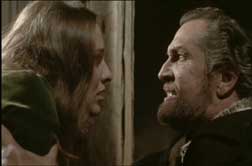 synthetic,
Nazi- like madman in SCREAM AND SCREAM AGAIN) gives a calm performance as the
priest; and booze-hound favorite extraordinaire, Hugh Griffith, has a humorous
bit part as a drunken (what else) grave digger. American B-movie vet Robert
Hutton has a bit part, as does 60s AIP starlet Quinn O'Hara (THE GHOST IN THE
INVISIBLE BIKINI).
synthetic,
Nazi- like madman in SCREAM AND SCREAM AGAIN) gives a calm performance as the
priest; and booze-hound favorite extraordinaire, Hugh Griffith, has a humorous
bit part as a drunken (what else) grave digger. American B-movie vet Robert
Hutton has a bit part, as does 60s AIP starlet Quinn O'Hara (THE GHOST IN THE
INVISIBLE BIKINI).
The film suffers from an obviously
low budget. Despite some picturesque locations, the sets are somewhat modest
and confined; the ballroom looks quite puny in comparison to other American
International productions of this ilk. The actual face of the Sidhe looks like
a $20 Halloween mask when seen in publicity photos. Fortunately, since it obviously
is not much more than that, Hessler is able to get around this problem. The
scenes with the monster are darkly lit, as not to expose too much of the make-up
limitations. One cleverly edited sequence has Roderick turning into the beast
as he walks up a circular staircase. Each time he steps out of total darkness,
his face is a bit more transformed. All in all, CRY OF THE BANSHEE is worthwhile
piece of gothic cinema and a nice edition to Vinnie Price's repertoire of chillers.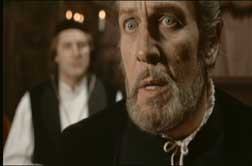
MGM's DVD transfer for CRY OF THE BANSHEE looks amazing. There's sharp detail, rich colors and little or no source blemishes to be found. As stated earlier, this is the uncut British version, previously available on VHS with a shapeless, open-matte transfer. Aside from looking far more handsome, the DVD also restores the film to its original 1.85:1 aspect ratio (Anamorphic), complimenting John Coquillon's beautiful camera work and intended compositions. The audio track crystal clear, with optional English, Spanish and French titles. For those who don't know, this British version runs a good four minutes longer and restores nudity, violence, as well as the tampering of scenes evident in the American cut. Terry Gilliam's animated opening montage and Wilfred Josephs' original score (the American version substituted it with boisterous music from Les Baxter) are also found here, and the film is now rated R, rather than PG.
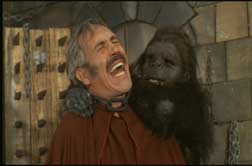 The
other title on this "Midnite Movies" double bill is MURDERS IN THE
RUE MORGUE, made by Hessler for AIP the following year. Again, MGM gives us
the never before released to video director's cut (the out of print Vestron
tape was of the theatrical cut), thought lost for many years. This version restores
about 11 minutes of footage and puts scenes back in their proper places, since
AIP tampered with it when first released and cut it down to 87 minutes and placed
it on a double bill with RETURN OF COUNT YORGA (Hey MGM, please deliver the
DVD of that baby soon!). Shot in Spain, this was a pretty lavish spectacle for
AIP at the time, and as one of their final gothics, it's also the last time
the studio did anything associated with Poe.
The
other title on this "Midnite Movies" double bill is MURDERS IN THE
RUE MORGUE, made by Hessler for AIP the following year. Again, MGM gives us
the never before released to video director's cut (the out of print Vestron
tape was of the theatrical cut), thought lost for many years. This version restores
about 11 minutes of footage and puts scenes back in their proper places, since
AIP tampered with it when first released and cut it down to 87 minutes and placed
it on a double bill with RETURN OF COUNT YORGA (Hey MGM, please deliver the
DVD of that baby soon!). Shot in Spain, this was a pretty lavish spectacle for
AIP at the time, and as one of their final gothics, it's also the last time
the studio did anything associated with Poe.
Since the original POE story had
been done several times earlier, Hessler and Wicking decided to approach it
at a different angle. Set in period France, the story centers on an acting troupe
who 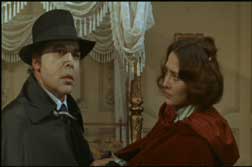 perform
Poe's "Murders in the Rue Morgue" as a spectacular Grand Guignol-style
stage play. The troupe is led by Cesar Charron (Jason Robards in one of his
few exploitation roles) who is married to the much younger Madeleine (Christine
Kaufmann). Madeleine keeps having strange, surreal dreams about an axe murderer
and other macabre apparitions. In the meantime, members of the acting troupe
are being nastily offed by the masked Rene Marot (Herbert Lom). Marot is believed
to be dead, but he's alive and well and seeking revenge by pouring acid on anyone
connected with his scarred appearance (leading to a bogus suicide) and his doomed
relationship with Madeleine's late mother (Lilli Palmer).
perform
Poe's "Murders in the Rue Morgue" as a spectacular Grand Guignol-style
stage play. The troupe is led by Cesar Charron (Jason Robards in one of his
few exploitation roles) who is married to the much younger Madeleine (Christine
Kaufmann). Madeleine keeps having strange, surreal dreams about an axe murderer
and other macabre apparitions. In the meantime, members of the acting troupe
are being nastily offed by the masked Rene Marot (Herbert Lom). Marot is believed
to be dead, but he's alive and well and seeking revenge by pouring acid on anyone
connected with his scarred appearance (leading to a bogus suicide) and his doomed
relationship with Madeleine's late mother (Lilli Palmer).
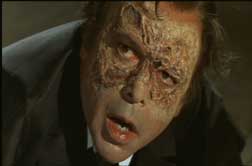 Wicking's
screenplay takes Poe's basic premise and injects some interesting ideas, while
Hessler's direction is filled with atmosphere and makes outstanding use of dream
sequences which make more sense in this longer cut of the film. Although Robards
was an excellent actor, he seems out of place and uninterested here (one can
only imagine what Vincent Price would have done with the part). Herbert Lom
steals the show as the Phantom of the Opera-style killer, and there's some notable
appearances by ex-Bond villain Adolfo Celi as a police inspector, dwarf actor
Michael Dunn as Marot's creepy assistant, Lilli Palmer as Madeline's mother,
and Spanish horror film regular Maria Perschy as a bordello hottie.
Wicking's
screenplay takes Poe's basic premise and injects some interesting ideas, while
Hessler's direction is filled with atmosphere and makes outstanding use of dream
sequences which make more sense in this longer cut of the film. Although Robards
was an excellent actor, he seems out of place and uninterested here (one can
only imagine what Vincent Price would have done with the part). Herbert Lom
steals the show as the Phantom of the Opera-style killer, and there's some notable
appearances by ex-Bond villain Adolfo Celi as a police inspector, dwarf actor
Michael Dunn as Marot's creepy assistant, Lilli Palmer as Madeline's mother,
and Spanish horror film regular Maria Perschy as a bordello hottie.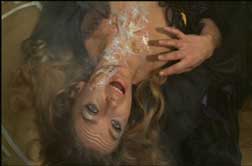 Most of these characters play more significantly in this longer director's cut,
and look carefully to spot a very young Brooke Adams (as a nurse) in a scene
that was originally deleted altogether. By the way, this version also had a
completely different (twist) ending then the 87-minute cut.
Most of these characters play more significantly in this longer director's cut,
and look carefully to spot a very young Brooke Adams (as a nurse) in a scene
that was originally deleted altogether. By the way, this version also had a
completely different (twist) ending then the 87-minute cut.
The DVD of MURDERS IN THE RUE
MORGUE looks just as good as BANSHEE. As a very colorful film, the colors here
are really vibrant, and detail is extremely sharp. It's presented in its 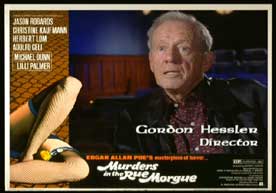 original
1.85:1 theatrical aspect ratio and Anamorphic. The mono audio sounds perfect
with no noticeable defects. There are optional English, Spanish and French subtitles
available.
original
1.85:1 theatrical aspect ratio and Anamorphic. The mono audio sounds perfect
with no noticeable defects. There are optional English, Spanish and French subtitles
available.
As an added bonus, both titles include appropriate featurettes with director Gordon Hessler. Banshee's featurette is entitled "A Devilish Tale of POE" and has the director talking about his early days working for Alfred Hitchcock on his TV program, hooking up with AIP for DE SADE but eventually abandoning it to do THE OBLONG BOX. He then goes on to speak about the production (and the great fun had on) CRY OF THE BANSHEE. RUE MORGUE's featurette is entitled "Stage Tricks & Screen Frights," and Hessler talks about the film, questions why Vincent Price didn't do it, and discusses the problems he had with AIP when they wanted to (and did) re-edit it entirely. Both featurettes are nicely edited; contain some very rare behind-the-scenes shots; and Hessler gives an informative, well-spirited chat. Also included on this package are the two films' original theatrical trailers. This disc comes highly recommended from this reviewer! (George R. Reis)